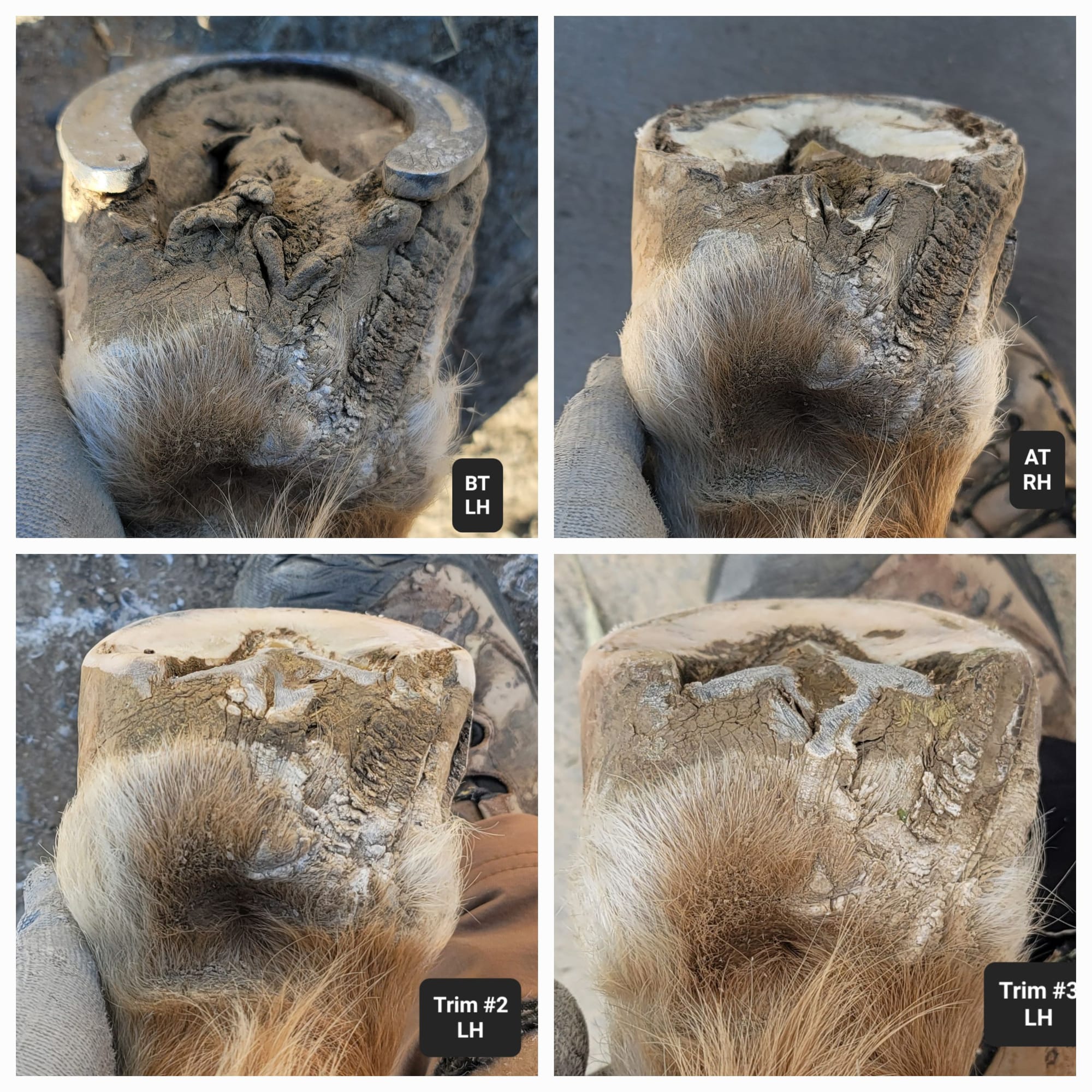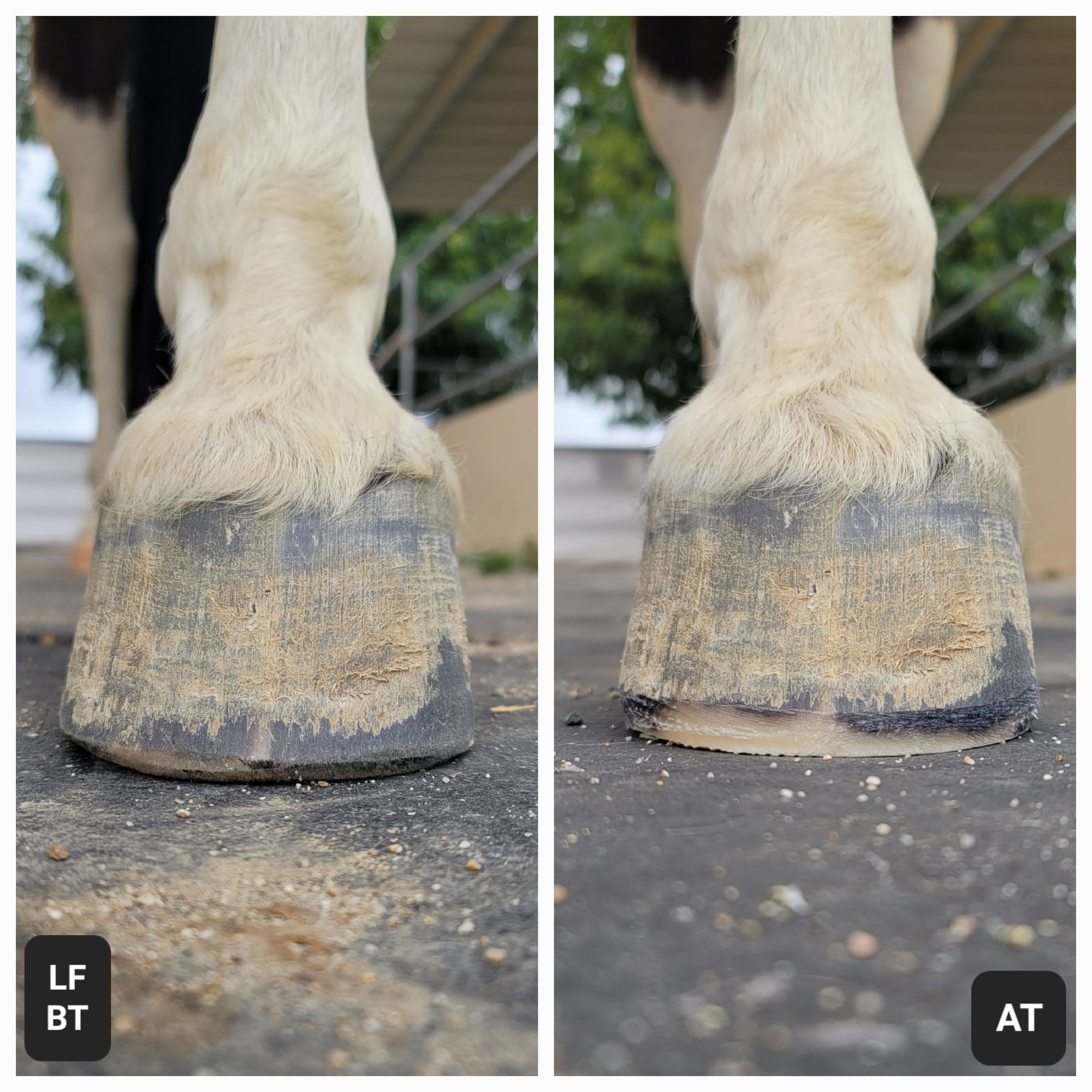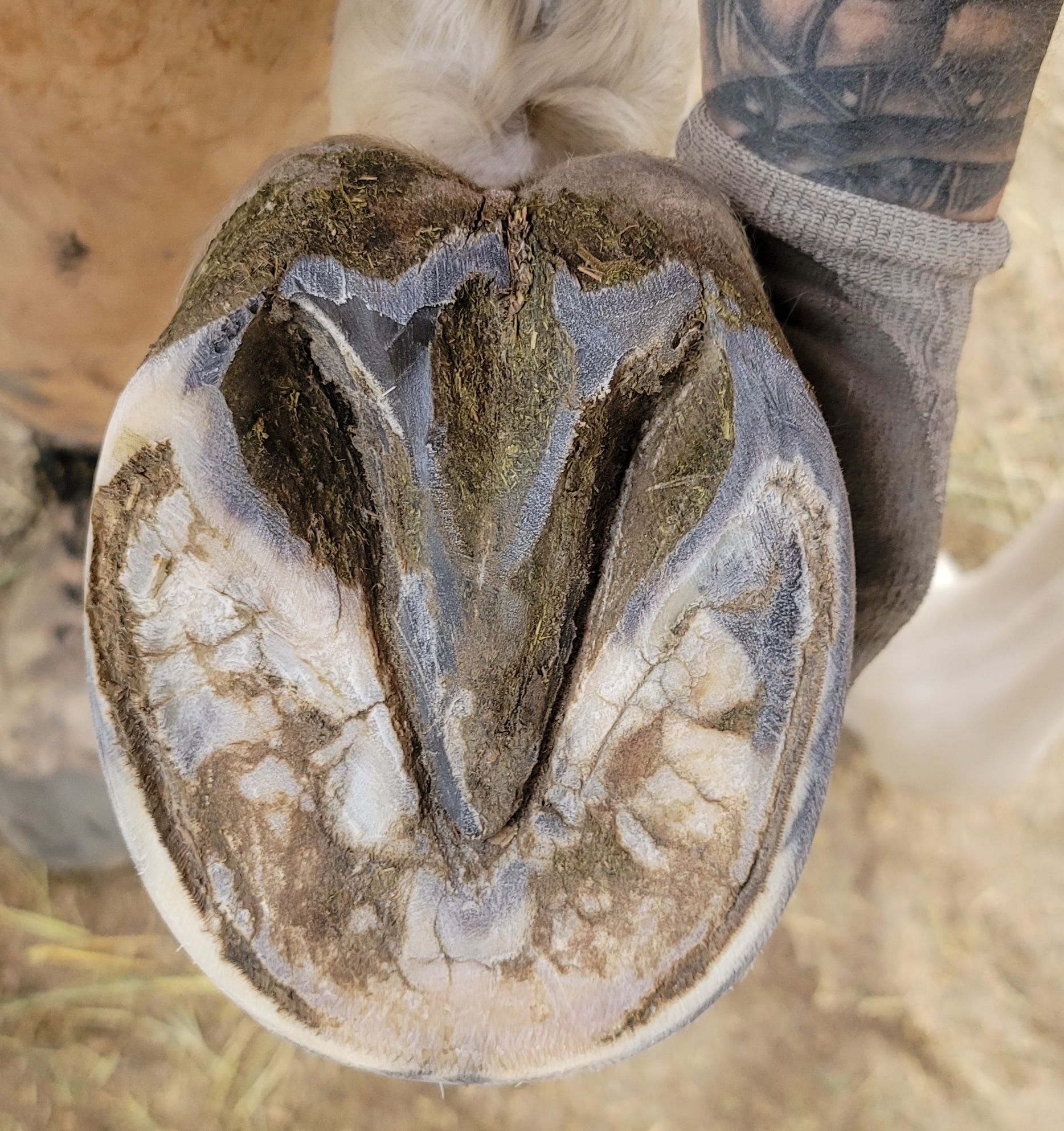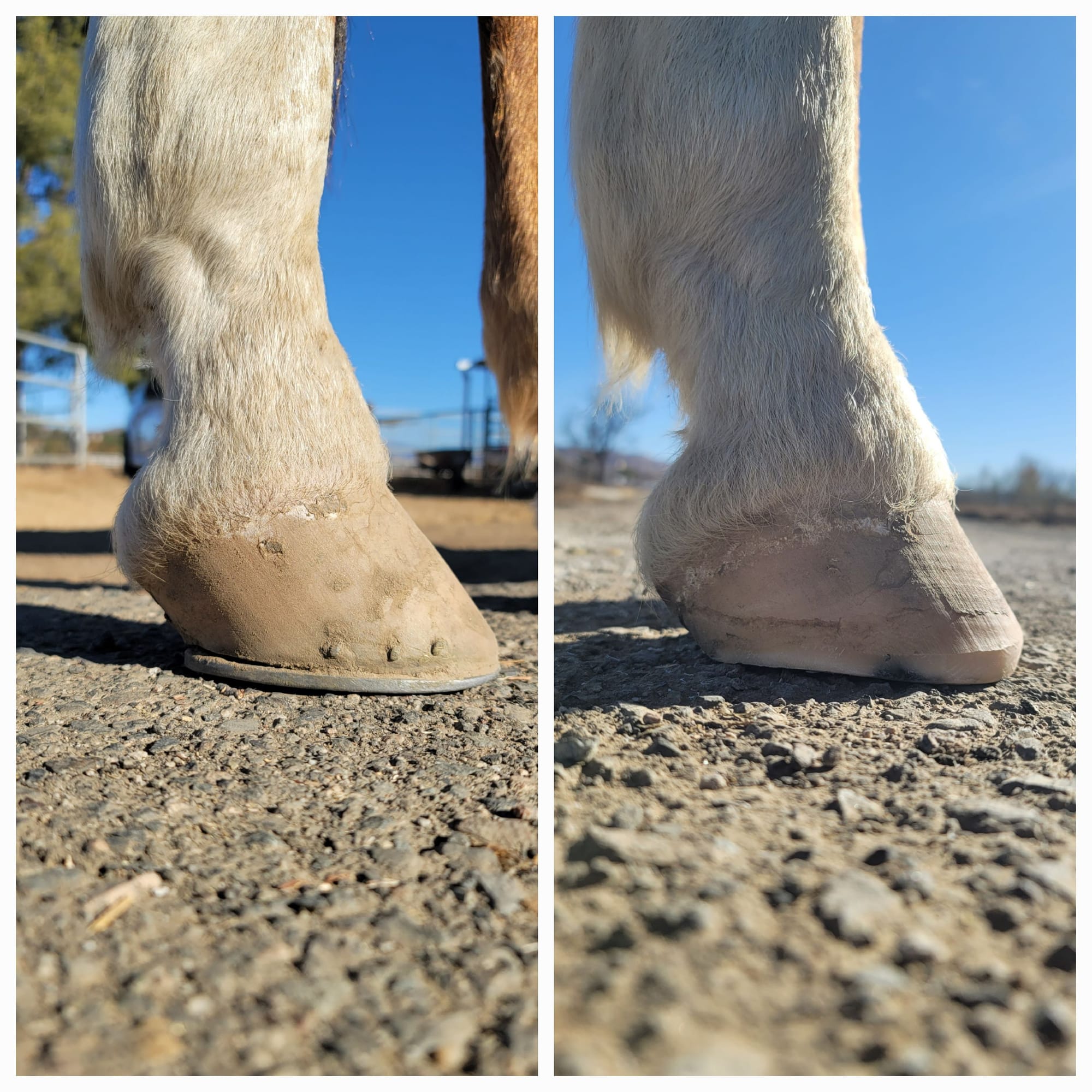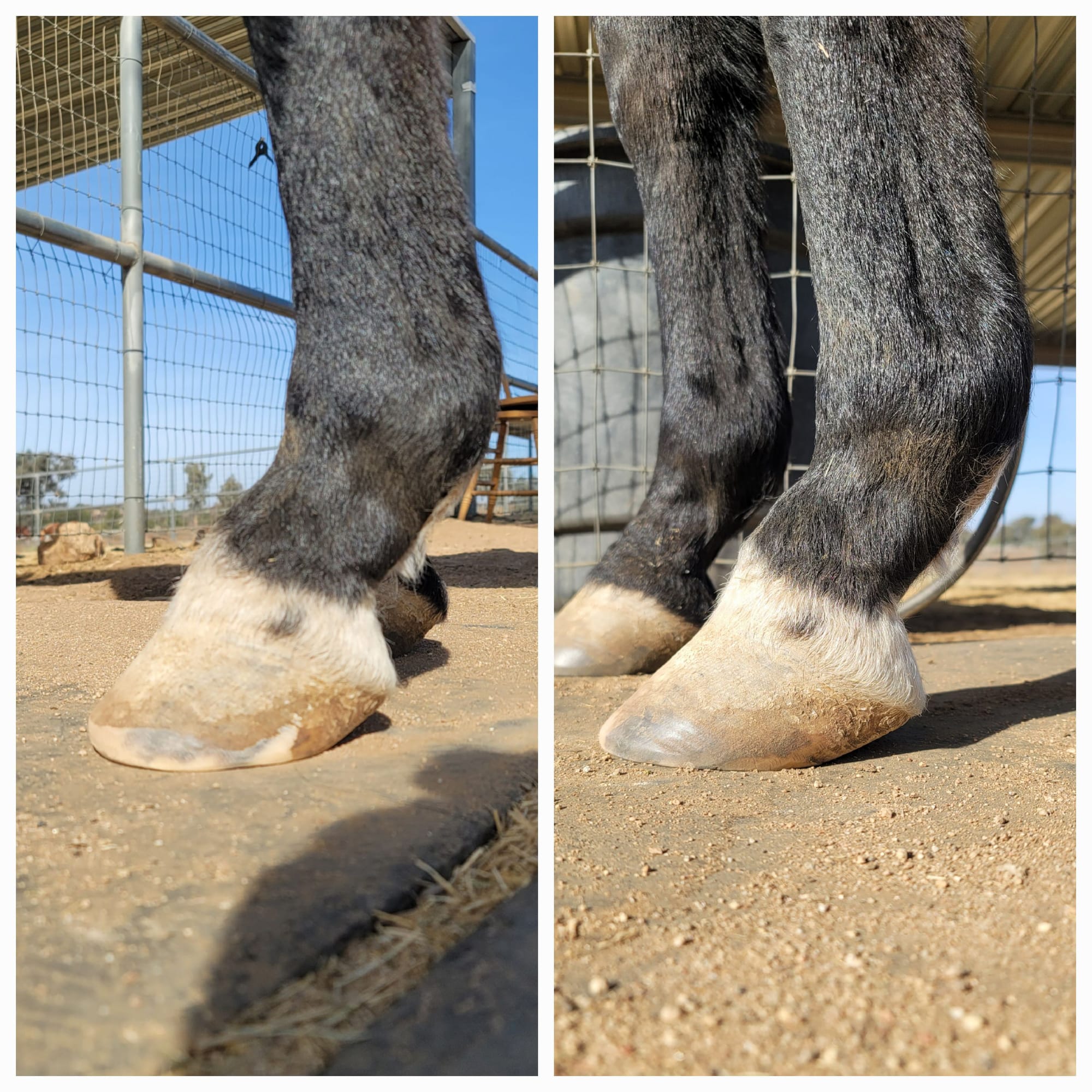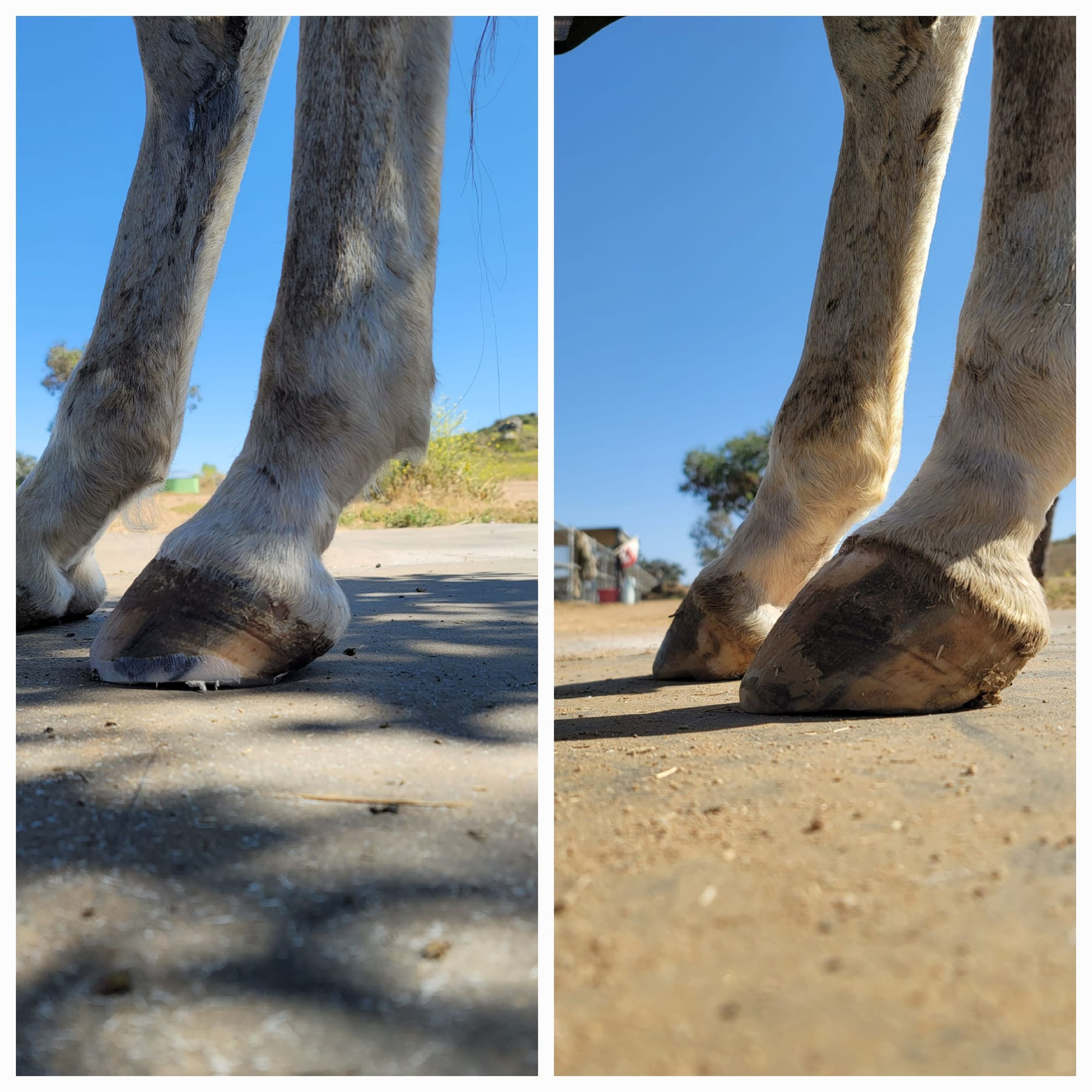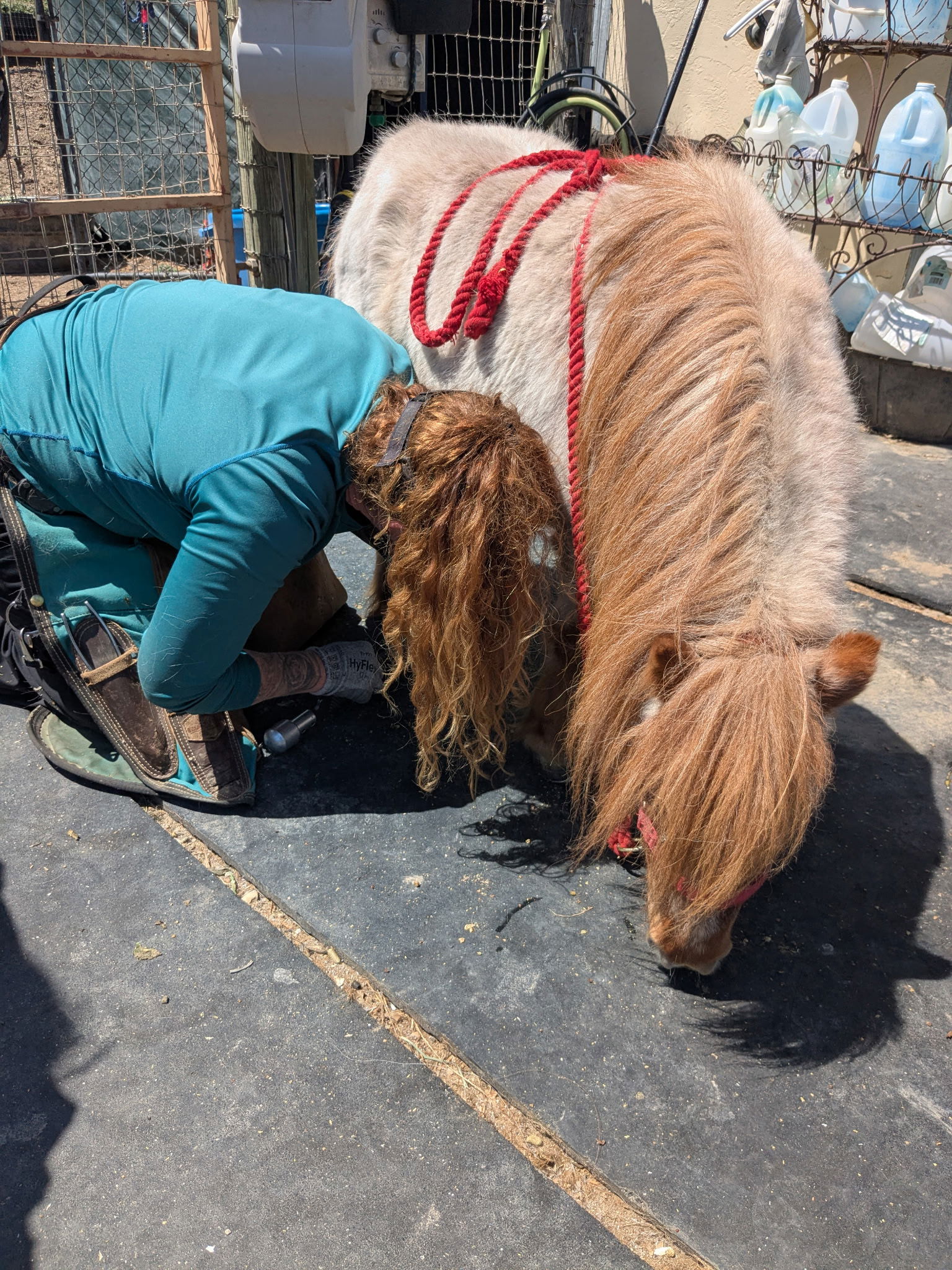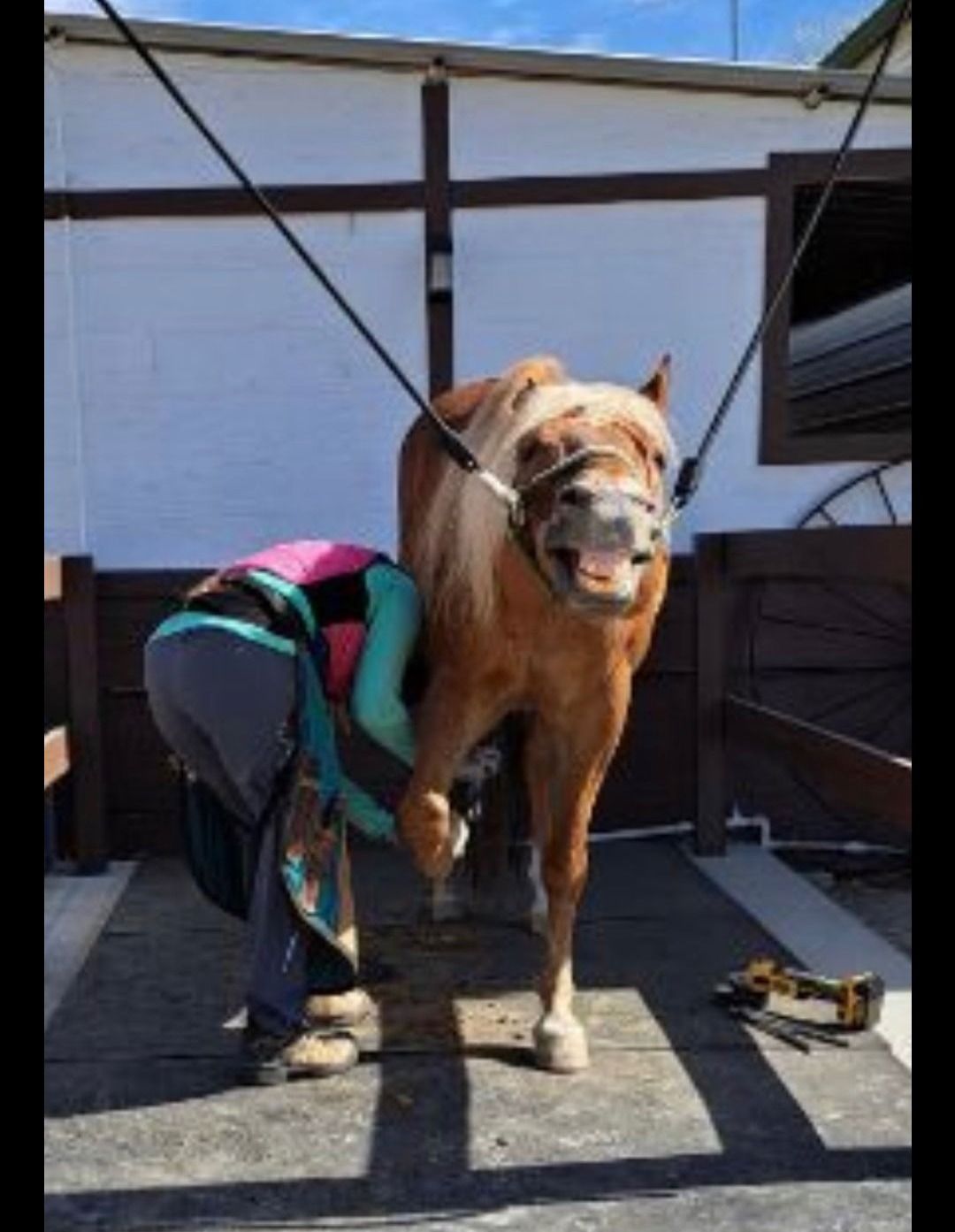Allegra's Equine Connections
Barefoot hoof Trimming
Are you looking for a certificated PHCP Hoof Care Provider (HPC) in Menifee, Winchester, Murrieta, Temecula, Lake Elsinore, and surrounding areas? Send me a message and we can chat!
I welcome clients who are interested in keeping their horse comfortably barefoot via maintenance trims, or who are looking to take their horse barefoot from metal shoes. As a Hoof Care Provider, I am focused on the function and ability of the natural hoof.
Services Provided:
*Maintenance Trims
*Rehabilitation Trims
*Shoe Removal
*Consultations
*Hoof Trimming lessons/cadaver lessons
*Hay Testing Services
*Scoot Boot Fittings
*Casting
*Glue-Ons
I trim on a 4-6 week cycle unless the hoof dictates sooner. Sometimes horses need micro adjustments to continue to be comfortable. Waiting too long will only cause too much overgrowth and unbalance. This can be challenging for many horses because the trim and rebalance can create soreness. This soreness can be foot related, but most likely is located up the leg in the joints, tendons, muscles and fascia.
For more information about PHCP or to find a practioner in your area: https://progressivehoofcare.org/directory/
The trim:
The trim should do no harm and keep the horse moving comfortably while landing heel first. Do you know what heel first landings look like? Get your phone out and video you horse in slow motion! Does your horse land heel first or are they avoiding their heels because of some type of pain or imbalance in their trim?
The trim varies horse to horse. When meeting a horse, I have to take everything into consideration; diet, movement, history, type of riding, and where the horse is kept. I watch how the horse stands and how the horse moves, it is important! A horse's body mechanics and confirmation are important too. Many times a horse is holding onto trauma or pain. This can effect the horse all the way down their boney column to the hoof. The hoof doesn't stand alone!
The hoof talks. From the outside we can see events that might have influenced its growth such as an abscess, infection, or a stressful event. Do some horses have "bad" feet? Yes, but we humans created that throughout their lifetime (this is a bigger discussion for later). The quality or hoof horn reflects the horse's nutrition along with how much movement they get.
From the solar view I can get an idea of hoof health as well. Without a radiograph I can't be certain, but I can see sole thickness, bars, look at the wall connection, health of frog and caudal foot, identify balance, see pressure from the coffin bone, and see/smell thrush.
Bottom line, the foot gives away a lot of information. Unfortunately, the majority of feet we see out there in the world are unhealthy. Can they recover? That depends on your level of commitment toward your horse!
Hoof Boots:
I love Scoot Boots! My horses ride in them. I do have a fit kit so I can size for you and process an order if you would like. I don't carry boots in stock or on hand, but I can still help in any way.
Composite Glue-ons:
Composite shoes can be a life saver for a horse! I absolutely believe in them when it's appropriate for the horse. There are many out there to choose from and finding the right one for your horse might take some time. I don't believe they are a permanent solution. They can absolutely help in certain transitions.
Picking your horse's feet and Thrush:
This is important! Many horses will end up with thrush in both wet and dry environments It is usually black and stinky. Thrush can eat its way to live tissue!!!
Try to pick your horses hooves daily to prevent it. Regular trims will help remove any flappy areas of the hoof that trap debris. Healthy diet can also influence thrush. This means gut health. Horses that are metabolic, struggling with IR or PPID might have thrush that just doesn't go away! If you are struggling with a chronic case, consider the diet and gut health of the horse.
If your horse has a deep central sulcus in the middle of their frog, then they are going to be heel sore. Hoof treatment is needed as soon a possible. The quickest and easiest is diaper rash cream and foot fungus cream mixed together. Stuff the cream with cotton shreds or some gauze into the crack using a clean hoof pick. From personal experience, this is effective and does not hurt.
There are many treatments available to try depending on what is going on with the hoof. I recommend Hoof stuff or other Red Horse products (https://redhorseproducts.com/shop/hoof-care/hoof-stuff/)
Here is an example of a horse that went too long between trims and has flappy/trappy material. The "flappy" pockets, the excess bar and frog is a perfect environment for thrush to grow.
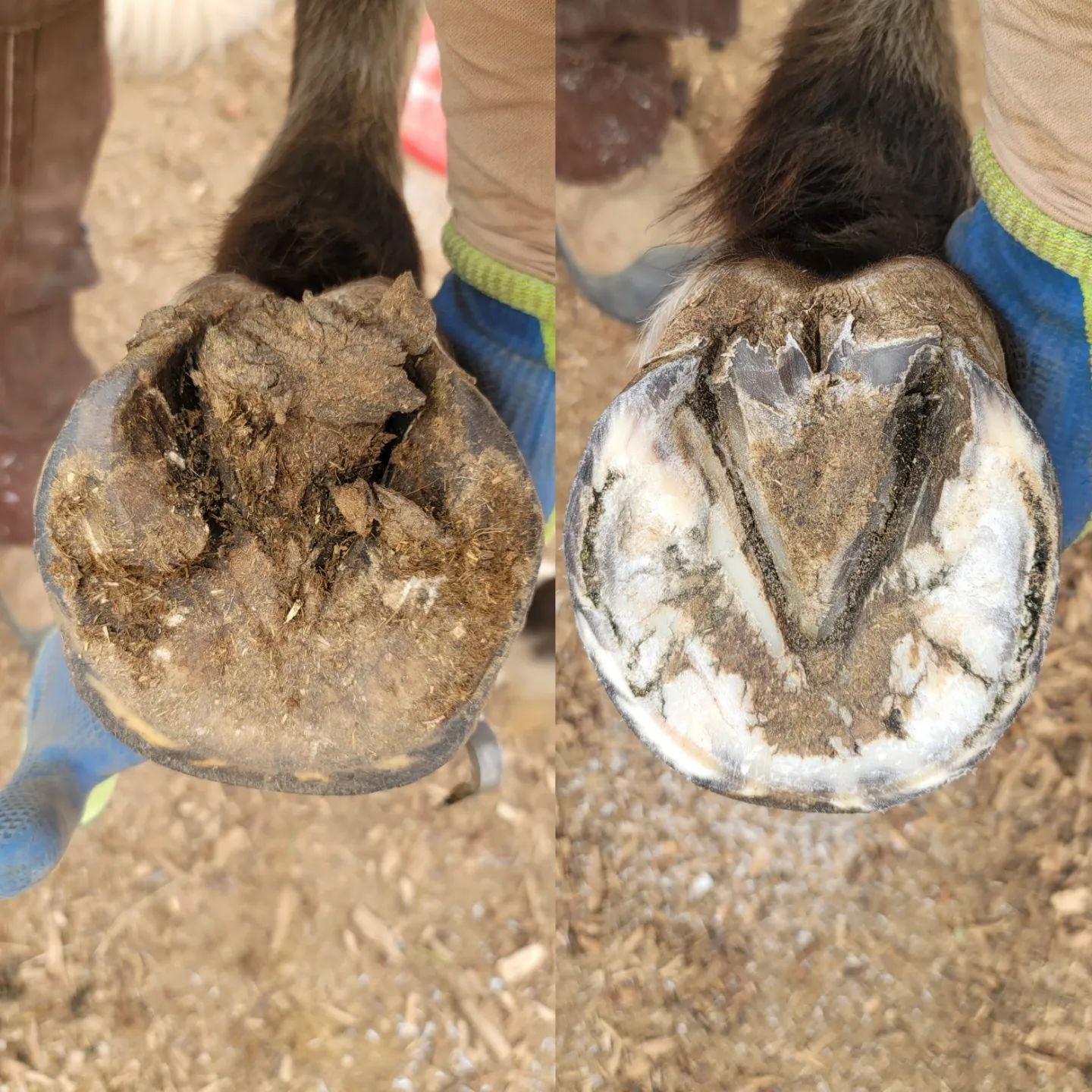
riding lessons

Horse Lessons
Does your child LOVE horses? I offer one on one lessons. My program is different because I just don't put your child right up on a horse. We work on skills that help your child learn and become comfortable with horses. Those skills include haltering, brushing, and walking the horse. Learning how horses communicate and understanding their body language to develop your child's horsemanship skills are important! I offer weekly hour long lessons. Consistency in my program is the goal because I want your child to develop a relationship with the horses. Something that separates me from others is I can use the horses and integrate Academic Tutoring. The lessons are now even more customized based on your child's learning goals. The horses can be highly motivating to read, study vocabulary, learn about science, understand math. Luna LOVES listening to children read books to hear! Students with IEPs are welcomed. Contact me so we can chat about what lesson might be right for your child.
Hoof Clients
For your horse to have the best possible trim, we all have to work together as a team. Please look over what I have listed below so we can plan for success!
Your Trimming Appointment:
* I need you to be there and be present for our first appointment. That could mean different things for different horses. Your horse will let us know, what works. I ask that you are open to my suggestions to make it more comfortable for us and ultimately keeps me safe. If it is determined that you are not needed to be at future appointments, I will let you know.
*If your horse has struggled in the past or has had behavioral issues, please let me know at the time of our first conversation. If your horse has had an injury of some sort since I last trimmed, let me know.
*I might give you homework. If your horse is struggling to stand for whatever reason, I will provide you with suggestions to help the trim go more smoothly for next time. Please know that I am looking out for everyone in this situation, I am not judging.
*Please be ready for the appointment. Have your horse caught and cleaned up ready to go. I don't mean prepare them for a show, I simply ask you pick out their feet.
*I am looking for a safe environment that has SHADE protection to trim under. When and if it rains, I ask that you clean your horse up before I arrive. Wet and muddy feet and legs destroy the tools and it's just not optimal for safety.
*My job is dangerous as I am working under a 1000 pound animal that has a fight instinct. It isn't natural for them to want to give up their foot to be held in the air. Holding up a foot takes practice. That practice is your responsibility. I have plenty of suggestions to help you out with, but training and trimming the horse isn't the job. If you would like it to be, let me know, and realize that the rate will change to reflect both.
*Not all horses are capable to hold a foot up for the amount of time that it takes for a trim. I understand this. I do work with your horse on this and have accommodations that I can provide. Using a grinder to trim will allow me to work much faster and it might be the best option for your horse. But, it is your job as their caretaker to make sure that they are not in pain for the trim, your vet can help you with that.
*The initial visit and other even visits could take more time because the hoof doesn't exist in isolation. Exercise, living environment, nutrition, history are all important factors. We will discuss this at our first visit. I will also take photos and videos prior to trim to track progress. This will take a bit longer that other visits. I do charge for this initial consultation/trim. If the time goes even longer, I might increase that price based on the time spent.
*Trim prices start at $75. There might be factors that impact that price and I have discussed some here. I would say the most common is that the horse can't stand for the trim. The price will increase to reflect the additional time I spent to trim your horse. Normally, I schedule each trim to be about an hour. Using the grinder for a trim will decrease this time significantly.
*Larger horses that are considered draft sizes, trimming prices start at $110.
*Payment is due at the time of the trim unless we have made arrangements for payment later that day.
*Finally, you stuck around to read this, I start each day with a goal to do my best for each horse I encounter that day. I always want to put forth my best trim. Sometimes, it's just not in the cards that day. Everyone has bad days, and horses can too. Whatever the reason might be for the horse to not stand its best for the trim, they get what they are able to stand for. Please know that I will always ensure specific points of the trim is addressed.

A Horse's Needs
Let's Chat a bit about the horse's needs:
For the stalled hoof, there are 3 major components to its health; diet, movement and trim. (Let's be honest, most horses in our area are in stalls).
Movement: Movement, movement in any way possible is best for the hoof! It is really important for your horse to be able to move comfortably and daily.
Hand walking, riding, pasture turnout, and even better, a track system (google Paddock Paradise). However, true exercise for a horse is continuous movement that increases their heart rate for a minimum of 20 mins daily is vital, especially for the IR/EMS horse. The more movement a horse gets, the more blood flow to the hoof, the healthier it can be!
To encourage movement in a turn out or pasture, If possible, hang hay bags/nets (with small holes) and put water in various places so that you horse has to move to eat and drink! Yup, this is more work for you, but isn't your horse worth it!?
Diet: We can tell what a horse eats just by looking at the hoof!
In the wild, horses are naturally grazing and browsing over a variety of plants. Meaning, they forage! Their digestive system is intricate with a Foregut and Hindgut always moving food throughout. The digestive system is made up of the Esophagus, Stomach, Small Intestines, Large Intestines, Cecum, Large Colon, Small Colon and Rectum and all have different yet important roles.
Horses should be fed with small frequent meals to allow for food to "stay" in their system. In nature, horses feed on a variety of plants, bark, and grasses. They are able to self select what they need and they do it all in movement.
Unfortunately, stalled horses don't get that opportunity to move and self select. Stalled horses are feed meals, usually 1 to 2 flakes in their stall. Always in the same place and time. This can be hard on their systems. They will end up waiting long periods of time between meals which means food isn't continuously moving through their system. In addition, they are just standing around in their stall. This routined feeding and lack of movement does not help the overall health of the horse. They are meant to move!
There is no blood flow to a hoof if a horse is just standing around, not to mention the lack of food being processed through the digestive system!
Grains and other feeds that are high in starch and sugars should be avoided at all costs (in my opinion) for the regular horse! Horses that are riding for Endurance events would be the exception during times of work. However, if out of work, then that high sugary energy meal should be avoided.
Fresh grass pastures should be avoided in our areas. Most of us don't have the ability to rotate our horses on different pastures. When grass is long the stem is not in crisis. The shorter the grass is, the more it holds onto to sugar (photosynthesis) for energy to recover and grow more. This is the grass that your horse loves! Why wouldn't they, it's high in sugar! In addition, green grasses don't provide the necessary wear on the horses incisors.
Teeth is an another important topic, just ask me about it or search Dr. Teskey!
In an ideal world, testing the feed (hay or grass) would tell you the nutritional profile of your feed. I provide Hay Testing Services!!!!
Hay analysis would then tell you what you would need to supplement for the horse's diet. If a horse's feet look unhealthy (chips, cracks, waves, event lines, stretching of the laminae), then most likely there are missing certain nutrients and what they might be eating is too high in sugars. If you don't test your hay or can't because you board your horse, then there are a variety of supplements (ration balancers) out there, and my suggestions are Arizona Copper Complete, CalTrace Plus Pellet version, or Vermont Blend. My horses love the CalTrace Plus Pellet version.
Hay Testing
So Why Test your Hay?
Testing your horse's primary source of nutrition, hay, is the only way to truly know what the horse is eating as far as proteins, sugars, and minerals.
There is not a perfect hay out there. Not every horse can eat every hay. There are so many factors to hay production. Is the hay a cool season or warm season? When was it cut? How mature is the cutting? Did the farmer add nitrogen to the soil? What time of day was it cut? Worrying about this is overwhelming!
So get your hay testing to determine it's nutritional benefits. Then once that analysis is done, you can"balance" your horse's diet!
Otherwise, you are just guessing and possibly throwing money away without knowing.
The company I send the samples to is called Equi-Analytical.
Hay Testing through Equi-Analytical
I charge $65 plus travel depending on location.
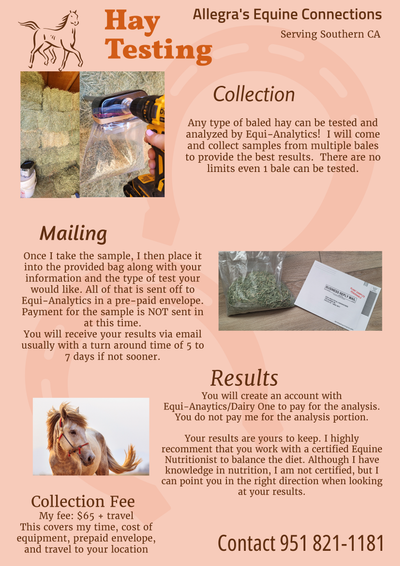
Contact
- 28791 Tulita Lane, Menifee, California, United States
About Me
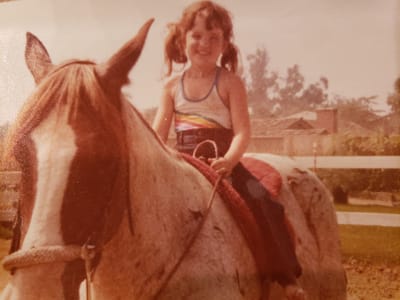
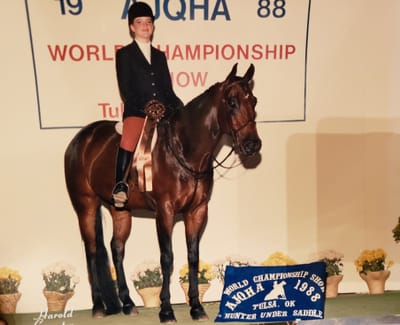
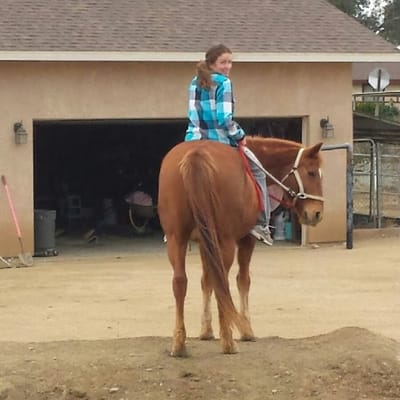
My dad always made sure I had a pony or horse in my backyard! I spent most of my childhood on the back of a horse if I wasn't in school. I have had many lessons and trainers that taught me many disciplines including English and Western styles of riding. Today, I even continue my riding education because I believe that we can always learn and grow no matter what we know!
Classes:
I want to continue to pay it forward by working with kids and my horses. I believe that working with horses can help an individual build confidence, self-efficiency, communication, trust, perspective, social skills, impulse control, learn boundaries and much more. Interaction with horses can also help regulate mood and relieve stress and anxiety.
My ultimate goal is your child walking away with a smile on their face and willingness to do it again! All children are welcomed including our LGBTQIA+ friends. Please contact me for any special considerations and needs. All classes are customizable to meet your child's needs.
Trimming:
Barefoot trimming is a passion of mine as well! Yes, I trim horses feet. I am a certificated PHCP member and trimmer. Making horses more comfortable and able to move better barefoot is so rewarding. but it takes more than just the trim. I work on their living environment, exercise, and diet.
And yes, my own horses are barefoot!!
So, whatever I can help you with, I look forward to meeting you!
